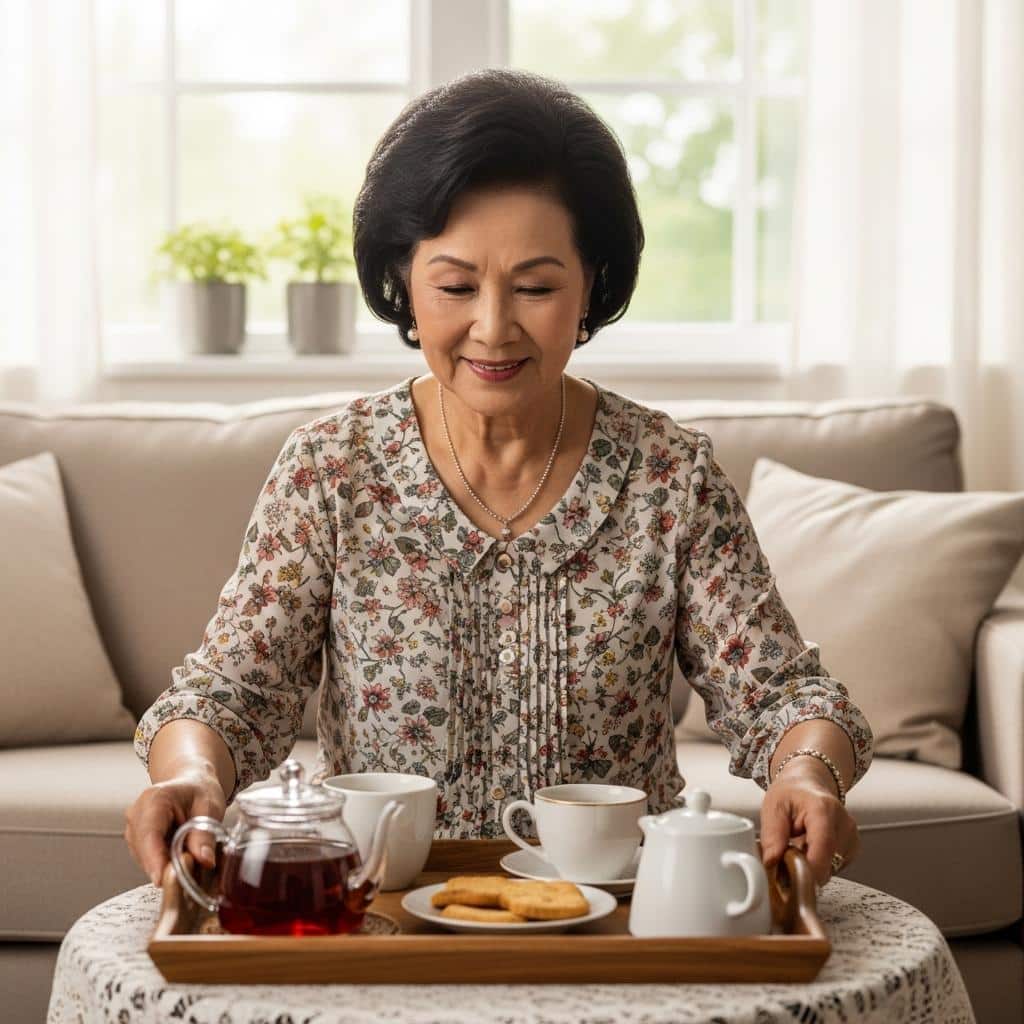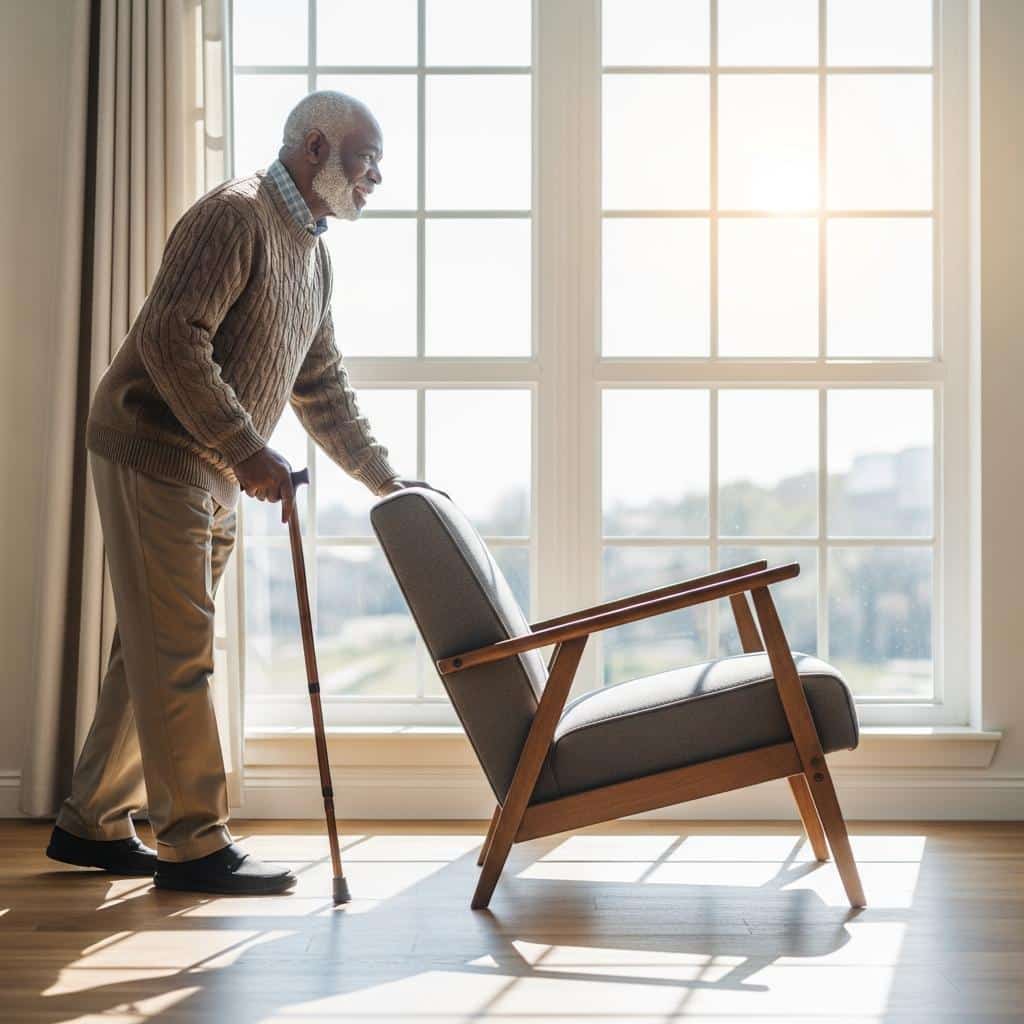Your living room might be sabotaging your visits without you knowing it.
You’ve probably felt it before. Your adult children come over, and within minutes, everyone’s staring at their phones or struggling to keep the conversation going. The silence feels awkward, and you’re left wondering why these visits feel so stiff when you used to talk for hours.
Here’s what most people don’t realize: it’s not about having better conversation topics or being more interesting. The problem might actually be your furniture arrangement.
The truth is, the way you’ve set up your living room could be making connection harder than it needs to be. But before you start rearranging everything, let me show you exactly what’s going wrong and how to fix it.

Why Your Living Room Layout Matters More Than You Think
Think about the last time your adult children visited. Where did everyone sit?
If you’re like most people, you probably have chairs facing directly across from each other. Maybe there’s a TV mounted on the wall. Perhaps the coffee table is pushed far away, making it awkward to reach anything.
These small details create big problems. Direct face-to-face seating can feel like an interview. A TV in the background competes for attention. And when there’s nothing to do with your hands, conversation has to carry the entire weight of the visit.
That’s a lot of pressure on everyone.
The Activity Station: Your Secret Weapon
Here’s the first game-changer: create a dedicated “activity station” in your living room.
This isn’t about turning your space into a game room. It’s about having low-commitment activities visible and ready to go. Think of it as giving everyone’s hands something to do while you talk.
What works best:
- A half-started jigsaw puzzle on a side table
- A deck of cards ready for easy games in plain sight
- Adult coloring books with nice pens nearby
- Current magazines fanned out on the coffee table
- A simple sketch pad and pencils
The magic here is visibility. Don’t hide these items in a cabinet or closet. When your adult children walk in and see a puzzle in progress or cards sitting out, they naturally gravitate toward them.
Why this changes everything: You’re no longer relying on conversation alone to fill the visit. Instead, you’re connecting through doing something together. Your hands are busy, the pressure is off, and conversations flow more naturally because you’re not forced to maintain constant eye contact.

The Refreshment Setup That Makes Everyone Feel Welcome
Have you ever noticed how the first ten minutes of a visit often involve offering drinks, figuring out what everyone wants, and running back and forth to the kitchen?
There’s a better way.
Set up a simple refreshment station before your adult children arrive. A small table or cart with a thermos of hot coffee, tea bags, water pitcher, cups, and a plate of simple snacks creates an instant sense of welcome.
Here’s what changes: your adult children can help themselves without feeling like they’re putting you to work. No more “Oh, don’t go to any trouble” conversations. Plus, having something to sip or nibble on gives everyone something to do during natural pauses in conversation.
Ready to discover more innovative strategies for healthy, comfortable aging? Subscribe to our newsletter for expert-tested tips and product recommendations designed specifically for older adults.
Create a Shared Focus Point
One of the simplest ways to reduce awkward silences is to give everyone something to look at together.
This is called a “shared focus object,” and it’s surprisingly powerful. When you and your adult children are both looking at the same thing, it takes pressure off direct eye contact and gives conversation a natural anchor point.
Ideas that work beautifully:
- Recent family photos displayed on a side table
- A window view with a bird feeder outside
- A plant you’re growing or caring for
- Your current hobby project (garden planning sketches, a craft you’re working on)
- A rotating display of treasured items with stories behind them
The key is keeping this dynamic. Swap out photos every few weeks. Move the bird feeder to a different window. Start a new project.
When your adult children arrive, you can naturally say, “Come look at this” or “What do you think about this?” Suddenly, you have something concrete to discuss beyond “How was work?”

The Seating Arrangement That Actually Feels Comfortable
Here’s where most living rooms get it wrong: chairs positioned directly across from each other.
This face-to-face setup might seem friendly, but psychologically, it creates tension. It feels like a performance. Everyone’s aware they need to maintain eye contact, react appropriately, and fill every silence.
Try this instead: angled seating at 90 degrees.
Two comfortable chairs positioned at a slight angle, both facing toward a window or toward your shared focus point, creates a completely different energy. You’re sitting together but not staring at each other. It mimics the feeling of taking a walk together or sitting side-by-side on a porch.
This small furniture shift can transform the entire visit.
Bonus comfort elements:
- Good lighting that’s not too harsh
- A throw blanket draped over the back of a chair
- Comfortable temperature control
- Soft background music at very low volume (optional)
The Tech-Lite Zone Philosophy
You can’t force anyone to put their phone away. But you can design a space where phones naturally become less interesting.
When your living room has engaging elements—that puzzle in progress, the comfortable seating angle, the interesting object to discuss—phones lose their appeal. The environment itself becomes more interesting than scrolling.
Keep the TV off during visits. Make sure lighting is warm and inviting, not harsh fluorescent that makes everyone want to look down. Have those visible activities available.
You’re not banning technology. You’re just making your living room the better option.

Build in a Natural Ending Point
One of the most awkward parts of any visit is knowing when it should end. Nobody wants to overstay, but nobody wants to seem rushed either.
Create a gentle ritual that signals the visit is wrapping up naturally. This takes the pressure off everyone.
Some ideas:
- Making tea together as a “closing activity”
- Taking a photo together before they leave
- Watering a plant together
- Walking them to the front door while discussing next week’s plans
The magic is that it gives the visit a sense of completion rather than an abrupt ending. Everyone knows what’s coming, and it feels intentional rather than awkward.
Want more expert advice on creating meaningful connections with your family? Join our newsletter for practical tips that help you stay engaged and independent as you age.

Start With Just One Change
You don’t need to transform your entire living room overnight. In fact, trying to change everything at once might feel overwhelming.
Pick one element from this list and try it during your next visit:
- Set up that activity station with a puzzle or cards
- Angle your chairs 90 degrees instead of face-to-face
- Prepare a simple refreshment station ahead of time
- Display something new that invites conversation
- Create a small closing ritual
The beauty of these changes is that they’re subtle. Your adult children probably won’t even notice you’ve rearranged things. They’ll just notice that somehow, this visit felt easier and more natural than usual.
Because here’s the truth: you’re not trying to create an Instagram-perfect space. You’re designing for connection.
When your environment does some of the work, conversation flows naturally. Activities fill the gaps. Comfort replaces tension. And visits start feeling the way they used to—easy, warm, and genuinely enjoyable.
Which change will you make first? Try one this week and notice what happens. You might be surprised at how one small shift transforms the entire feeling of your time together.

![Older couple walking guest to door[1]](https://www.grayingwithgrace.com/wp-content/uploads/2025/11/older_couple_walking_guest_to_door1-e1762196806496.jpg)
![Senior group autumn walk cane[1]](https://www.grayingwithgrace.com/wp-content/uploads/2025/11/senior_group_autumn_walk_cane1-e1762875262861-450x300.jpg)
![Older couple goodbye son porch sunset[1]](https://www.grayingwithgrace.com/wp-content/uploads/2025/11/older_couple_goodbye_son_porch_sunset1-e1762196602394-450x300.jpg)
![Elderly woman daughter garden bench[1]](https://www.grayingwithgrace.com/wp-content/uploads/2025/11/elderly_woman_daughter_garden_bench1-e1762196447145-450x300.jpg)
![Older couple family patiosunset smorestime[1]](https://www.grayingwithgrace.com/wp-content/uploads/2025/11/older_couple_family_patiosunset_smorestime1-e1762196246207-450x300.jpg)
![Elderly man daughter watering plants porch[1]](https://www.grayingwithgrace.com/wp-content/uploads/2025/11/elderly_man_daughter_watering_plants_porch1-e1762195936911-450x300.jpg)
![Older woman serving cookies daughter kitchen[1]](https://www.grayingwithgrace.com/wp-content/uploads/2025/11/older_woman_serving_cookies_daughter_kitchen1-e1762195809548-450x294.jpg)





